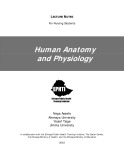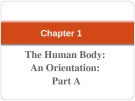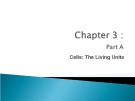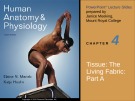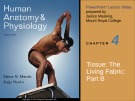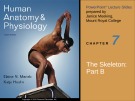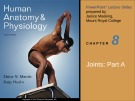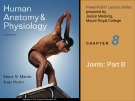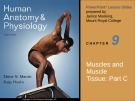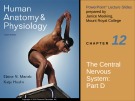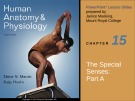
Structural organization of the human body
-
Human anatomy and physiology is more than just interesting, it is fascinating. To help get the students and instructions involved in the study of this subject, a number of special features are incorporated throughout the lecture note.
 428p
428p  phannguyenhaminhths
phannguyenhaminhths
 18-08-2021
18-08-2021
 25
25
 2
2
 Download
Download
-
Chapter 1 - The human body: An orientation (part a). This chapter presents the following content: Overview of anatomy and physiology, principle of complementarity, levels of structural organization, overview of organ systems, organ systems interrelationships, necessary life functions,...and other contents.
 28p
28p  tangtuy07
tangtuy07
 02-04-2016
02-04-2016
 49
49
 4
4
 Download
Download
-
Chapter 3 - Cells: The living units (part a). Just as bricks and timbers are the structural units of a house, cells are the structural units of all living things, from one-celled “generalists” like amoebas to complex multicellular organisms such as humans, dogs, and trees. The human body has 50 to 100 trillion of these tiny building blocks. This chapter focuses on structures and functions shared by all cells.
 36p
36p  tangtuy07
tangtuy07
 02-04-2016
02-04-2016
 65
65
 3
3
 Download
Download
-
Chapter 3 (part c) provides knowledge of the cytoplasm. This chapter describe the composition of the cytosol; discuss the structure and function of mitochondria; discuss the structure and function of ribosomes, the endoplasmic reticulum, and the Golgi apparatus, including functional interrelationships among these organelles; compare the functions of lysosomes and peroxisomes.
 30p
30p  tangtuy07
tangtuy07
 02-04-2016
02-04-2016
 49
49
 2
2
 Download
Download
-
This chapter list the steps involved in preparing animal tissue for microscopic viewing; list several structural and functional characteristics of epithelial tissue; name, classify, and describe the various types of epithelia, and indicate their chief function(s) and location(s).
 29p
29p  tangtuy07
tangtuy07
 02-04-2016
02-04-2016
 45
45
 3
3
 Download
Download
-
Connective tissue is the most abundant and widely distributed of the primary tissues, but its amount in particular organs varies. For example, skin consists primarily of connective tissue, while the brain contains very little. This chapter provides knowledge of connective tissue, indicate common characteristics of connective tissue, and list and describe its structural elements.
 48p
48p  tangtuy07
tangtuy07
 02-04-2016
02-04-2016
 40
40
 2
2
 Download
Download
-
Chapter 7 - The skeleton (part b) provides knowledge of vertebral column and thoracic cage. This chapter describe the structure of the vertebral column, list its components, and describe its curvatures; indicate a common function of the spinal curvatures and the intervertebral discs; name and describe the bones of the thoracic cage (bony thorax); differentiate true from false ribs.
 35p
35p  tangtuy07
tangtuy07
 02-04-2016
02-04-2016
 39
39
 3
3
 Download
Download
-
Chapter 8 part a provides knowledge of classification of joints, fibrous joints and cartilaginous joints. After studying this chapter you will be able to: Define joint or articulation, classify joints by structure and by function, describe the general structure of fibrous joints, name and give an example of each of the three common types of fibrous joints, describe the general structure of cartilaginous joints, name and give an example of each of the two common types of cartilaginous joints.
 59p
59p  tangtuy07
tangtuy07
 02-04-2016
02-04-2016
 38
38
 3
3
 Download
Download
-
Chapter 8 - Joints (part b) provides knowledge of synovial joints, homeostatic imbalances of joints and developmental aspects of joints. After completing this unit, you should be able to: Describe the structural characteristics of synovial joints, compare the structures and functions of bursae and tendon sheaths, list three natural factors that stabilize synovial joints, name the most common joint injuries and discuss the symptoms and problems associated with each,...and other contents.
 59p
59p  tangtuy07
tangtuy07
 02-04-2016
02-04-2016
 51
51
 7
7
 Download
Download
-
The main contents of this chapter include all of the following: Force of muscle contraction, avelocity and duration of contraction, muscle fiber type, effects of exercise, effects of resistance exercise, the overload principle, smooth muscle, peristalsis, microscopic structure, innervation of smooth muscle,...and other contents.
 47p
47p  tangtuy07
tangtuy07
 02-04-2016
02-04-2016
 40
40
 4
4
 Download
Download
-
After completing this unit, you should be able to: Describe the embryonic development of the spinal cord; describe the gross and microscopic structure of the spinal cord; list the major spinal cord tracts, and classify each as a motor or sensory tract; distinguish between flaccid and spastic paralysis, and between paralysis and paresthesia;...
 49p
49p  tangtuy07
tangtuy07
 02-04-2016
02-04-2016
 47
47
 3
3
 Download
Download
-
Chapter 15 (part a) provides knowledge of the eye and vision. In this chapter, you will learn to: Describe the structure and function of accessory eye structures, eye layers, the lens, and humors of the eye; outline the causes and consequences of cataracts and glaucoma; trace the pathway of light through the eye to the retina, and explain how light is focused for distant and close vision; outline the causes and consequences of astigmatism, myopia, hyperopia, and presbyopia.
 39p
39p  tangtuy07
tangtuy07
 02-04-2016
02-04-2016
 42
42
 2
2
 Download
Download
-
After completing this unit, you should be able to: Describe the structure and general function of the outer, middle, and internal ears; describe the sound conduction pathway to the fluids of the internal ear, and follow the auditory pathway from the spiral organ (of Corti) to the temporal cortex; explain how one is able to differentiate pitch and loudness, and localize the source of sounds;...
 37p
37p  tangtuy07
tangtuy07
 02-04-2016
02-04-2016
 25
25
 2
2
 Download
Download
-
One of the greatest challenges to confront an artist is drawing the human figure. Our bodies are infinitely complex yet intimately familiar, giving rise to a subject that is difficult to depict accurately yet judged incessantly. The human figure is almost overwhelmingly complex for the artist to draw. The human figure is an organic structure that defies geometric simplification. It is composed of bones, muscles, and organs, all of which are covered by a flexible layer of skin. The body has many moving parts that make it almost impossible to define as a shape. Within its skeleton are more...
 16p
16p  audi123
audi123
 31-07-2010
31-07-2010
 178
178
 29
29
 Download
Download
CHỦ ĐỀ BẠN MUỐN TÌM








